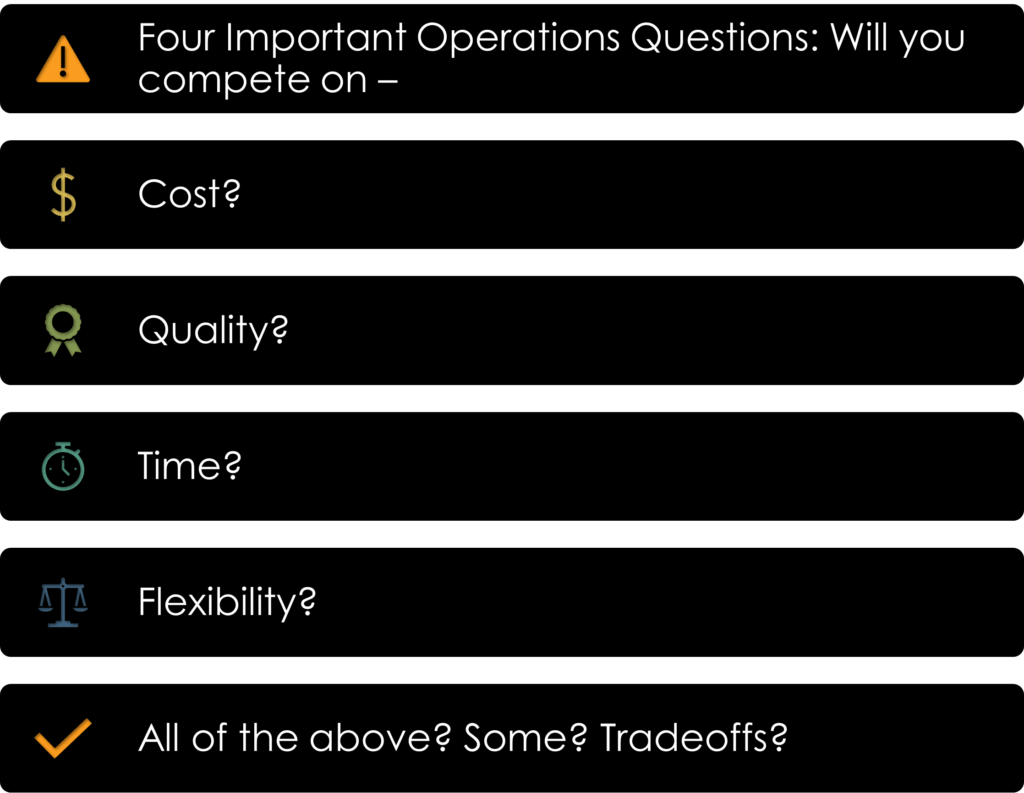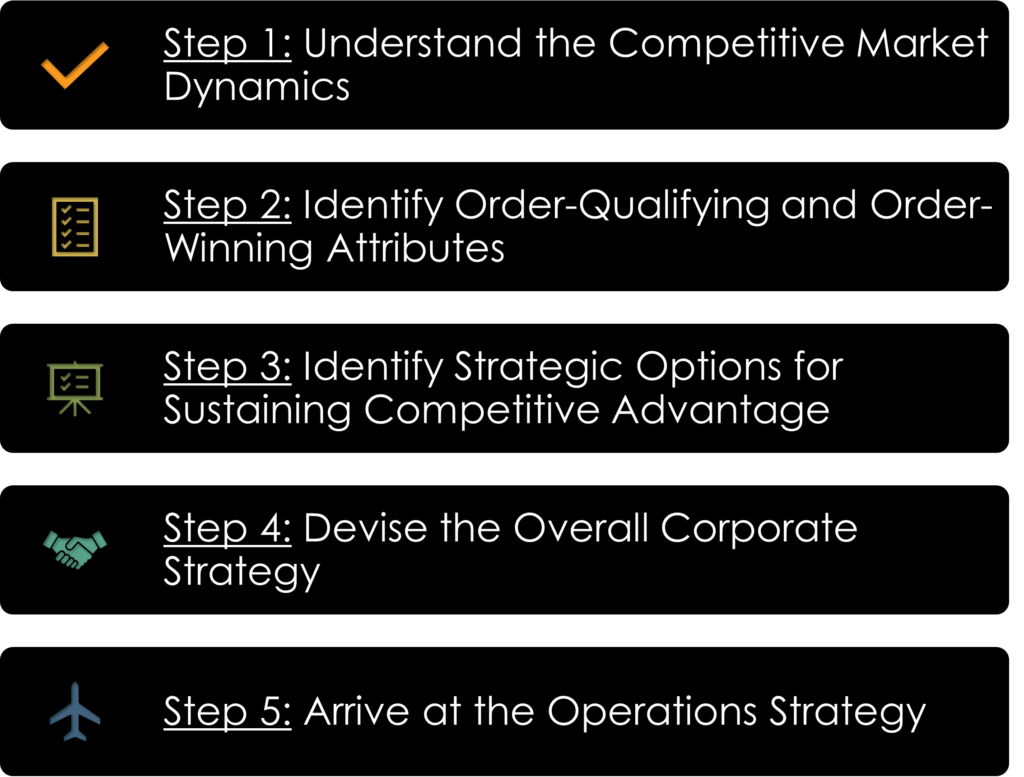Operations Strategy: Definition and Purpose

Definition
Operations strategy is set of decisions and actions which set the role, objectives, and activities of operations so that they contribute to, and support the organization’s business strategy. Following are the main characteristics of an operations strategy.
- It is a process by which key operations decisions are made that are consistent with the overall strategic objectives of a firm.
- A strategic planning exercise that enables an organization to respond to the market needs in the most effective manner, by aligning various resources and activities in the organization to deliver products that are likely to succeed in the market.
- A set of decisions in the operations function that are made based on the inputs from the overall corporate strategy.
However, before we begin to understand the process of formulation of operations strategy, we must understand how our products can fulfill market requirements and go beyond to create a winning edge.
Order Qualifiers and Order Winners
Order qualifying attributes are the set of attributes that customers expect in the product or service they consider for buying
Order winning attributes are other attributes that have the potential to sufficiently motivate the customer to buy the product or service
What constitutes order winning and order qualifying might change from time to time.
- During the early 1980’s providing superior quality products was an order winning attribute. However, in the 1990’s quality became an order qualifying attribute as customers began to expect high levels of quality.
- Order winning attributes include efficient consumer response, speed, variety and convenience.
Competitive Advantage
Competitive advantage is term as the extra edge that a firm has over their industry peers (Reid and Sanders, 2005). It is something allows a firm to make better offers to its customers and cannot be replicated by its competitors in the near future.
The capability of a firm in managing their operation can be transformed into their competitive advantage if they can identify and tap into their intangible resources.
Sources of Competitive Advantage
These are the resources that are available to a firm, which if utilized properly, can give the firm an edge over the competitors in terms of a better offering in the market that becomes a compelling reason for the customers to prefer your products over the competitor’s products. Resources like availability of skilled workforce, efficient plant & machinery, and priority access to premium raw materials are some examples of resources that can lead to a firm building a sustainable competitive advantage in the market.
Generic Competitive Priorities
They provide critical linkage between order winning and order qualifying attributes, and the choices made in operations. They help organizations evaluate how well the operations system is responding to the requirements at the marketplace and serve a useful purpose in comparing performances amongst competitors and for benchmarking.
Four generic competitive priorities that are useful for developing measures for operational excellence are Quality, Cost, Delivery and Flexibility.

Operations Strategy Formulation Process
Let us look at the five basic steps that are essential for arriving at the operations strategy for an organization.

Step 1: Understand the Competitive Market Dynamics
Before we set out to craft any strategy, we must carefully understand the competitive environment of our business. This helps us to make a strategy that is relevant. In order to achieve the business objectives, it is important to understand the category requirements, fulfill them and stay on top of the category by staying differentiated and ahead of competitors.
Step 2: Identify Order-Qualifying and Order-Winning Attributes
It is always important to offer order qualifying attributes to our products for them to be even considered by our customers. In the absence of the order qualifying attributes, the customers and the market will outright reject our products. Having done that, we need to plan for order winning attributes and as the name suggests, these are the attributes that place us above our competitors. Remember order winning attributes must be relevant and useful to our customers, then only will they add value to our products.
Step 3: Identify Strategic Options for Sustaining Competitive Advantage
In order to create a sustainable competitive advantage, look at the resources available to the firm and differentiate your products on at least one of the competitive priorities discussed above.
Step 4: Devise the Overall Corporate Strategy
The overall corporate strategy strives to achieve the business objectives. However, the overall corporate strategy rides on the individual functional strategies that derive their objectives from the business objective. So the overall corporate strategy is the guiding light and shows us the direction in which our operations strategy must point to.
Step 5: Arrive at the Operations Strategy
Given the above, the operations strategy derives its objective from the business objective and the strategy is thus formulated, taking cues from the business strategy of the firm.
Check out the following video that gives you further insights on operations strategy.
Measuring Operations Productivity
Total Productivity
It is a measure of how efficiently inputs are converted to outputs and simply put productivity is measured by dividing the total output by the total input, i.e. productivity = output/input. In order to numerically measure productivity, we must assign numbers to inputs and outputs. We do so by taking the total sales revenue is the output and the total expenditure as the input. Then the total productivity = $sales/$inputs.
Partial Productivity
Partial productivity is when you want to measure the productivity relationships between a specific input and a specific output related to that input. So for example, partial productivity for a car manufacturer = no. cars produced/no. of employees in the company.
Multifactor Productivity
Multifactor productivity is when you want to measure the output against multiple inputs. Take for example, you want to study the productivity of fuel, raw material and electricity consumption. Then in this case the multifactor productivity = $sales/($fuel cost +$raw material cost + $electricity cost).
Also Read – Introduction to Operations Management
Summary
Business strategy is a roadmap towards achieving organizational objectives. Functional strategies are the components of this roadmap that help them achieve their own objectives in line with the business objective. The following points must be noted while formulating operations strategy.
- The strategy must address mission, environment, and core competencies.
- Business strategy provides a guide for designing operations strategy.
- Operations strategy must consider which competitive priorities are essential to meet business objectives.
- Competitive priorities are cost, quality, time, and flexibility.
- Productivity measures how effectively a firm is using resources.
- Productivity is computed as a ratio of outputs divided by inputs.
-End of Chapter-









